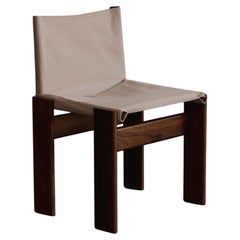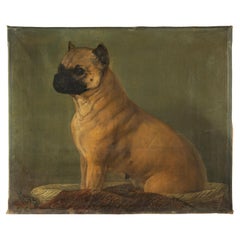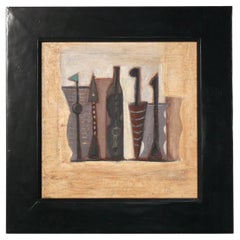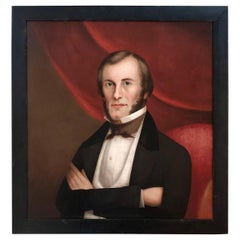Canvas Furniture
to
1,624
6,727
4,290
9,485
1,071
905
1,649
1,524
219
208
190
187
182
176
105
57
52
51
49
42
40
33
33
26
836
1,863
6,785
1,976
899
2,433
2,185
98
60
167
170
168
341
629
720
356
268
80,626
356,412
296,171
230,523
149,846
6,034
3,427
3,036
1,834
1,014
11,461
11,082
11,169
137
127
43
39
31
Material: Canvas
Afra & Tobia Scarpa "Monk" Dining Chair for Molteni, Ivory Canvas, 1974
Located in Lonigo, Veneto
Afra & Tobia Scarpa "Monk" dining chair for Molteni, ivory canvas and walnut, Italy, 1974.
The particular feature of this model is the support structure composed of two equal trestl...
Category
1970s Italian Mid-Century Modern Vintage Canvas Furniture
Materials
Canvas, Walnut
A Large Directoire Period Painted Seven- fold Screen, French Late 18th century
Located in ARMADALE, VIC
A Large Directoire Period Painted Seven- fold Screen, French Late 18th century
Height: 175 cm Width: 420 cm fully extended Depth: 3 cm each panel
Provenance: Private Australian Col...
Category
Late 18th Century French Directoire Antique Canvas Furniture
Materials
Canvas, Hardwood
19th Century Oil Painting - Portrait of a Dog - Pug
Located in Casteren, Noord-Brabant
A beautiful antique oil painting, portrait of a pug.
The painting is signed and dated, 1881, but the signature is not legible.
The painting is in ori...
Category
Late 19th Century Belgian Antique Canvas Furniture
Materials
Canvas, Pine, Paint
Jock Macinnes Abstract Still Life Oil Painting
Located in Atlanta, GA
Modernist abstract oil on canvas painting, by Jock MacInnes, British, circa 1980s. Signed with artist's monogram and dated at lower ed...
Category
1980s English Mid-Century Modern Vintage Canvas Furniture
Materials
Canvas, Wood, Paint
Prairie's Edge Original Oil Painting By Heinie Hartwig
Located in Coeur d'Alene, ID
Original oil on board; 5" x 7". Painting portrays a Native American teepee camp scene in a desert clearing. A stunning colorful sunset frames the scene, featuring colors of blue, pin...
Category
Late 20th Century American Canvas Furniture
Materials
Canvas, Paint
19th Century Folk Art Painting of a Gentleman Attributed to Samuel P. Howes
Located in Wiscasset, ME
Oil on canvas.
Samuel P. Howes was born in 1806, likely in Plymouth, Massachusetts. As a young man, he began divinity studies but changed his career to painting and moved to Boston i...
Category
1830s American Folk Art Antique Canvas Furniture
Materials
Canvas, Paint
Early 19th Century Italian School Memento Mori Oil on Canvas Welcome Death
Located in Lowestoft, GB
A almost life size depiction of a human skeleton holding a length of chain, with a banner at the base.
We believe the piece to be Italian from the language used within the banner, ...
Category
19th Century Italian Antique Canvas Furniture
Materials
Canvas
Antique Painting Grape and Melon Eaters After Bartolome' Murillo 18th Century
By Bartolomé Esteban Murillo
Located in London, GB
This is a delightful antique Spanish oil on canvas painting after Bartolome' Esteban Murillo, depicting two peasant boys eating grapes and melon, Circa 1780 in date.
It features a ...
Category
Late 18th Century Spanish Baroque Antique Canvas Furniture
Materials
Canvas
19th Century Seascape with Brig Under Full Sail
Located in Nantucket, MA
19th Century Seascape with Brig Under Full Sail, British School, circa 1870, an oil on canvas seascape with a square-rigged Brig under sail on th...
Category
Late 19th Century English Victorian Antique Canvas Furniture
Materials
Canvas
17th Century Oil on Canvas Italian Painting Expulsion of Adam and Eve
Located in Vicoforte, Piedmont
Rare 17th century Italian painting. Oil on canvas artwork depicting the expulsion of Adam and Eve from the Garden of Eden, one of the most powerful and dramatic subjects in biblical ...
Category
1640s Italian Antique Canvas Furniture
Materials
Canvas
Antique 20thC Louis Vuitton Malle Haute Trunk In Monogram Canvas, France c.1910
Located in Royal Tunbridge Wells, Kent
An exquisite “malle haute“ (tall trunk) by Louis Vuitton, early 20th century. The malle haute is the largest of the standard sizes, any trunk larger than this one would have been cus...
Category
20th Century French Other Canvas Furniture
Materials
Brass
Vintage obi textile art "From the Ashes ~Serendipity~" by ikasu Beige, Japan
By Kimono ikasu
Located in Setagaya City, JP
About This Canvas
This canvas has been upcycled from an early 20th-century maru-obi, featuring a subtle yet sophisticated depiction of the phoenix—a legendary symbol of peace and ren...
Category
1910s Japanese Japonisme Vintage Canvas Furniture
Materials
Canvas, Silk
Still Life Oil On Canvas Painting, Garden Flowers in Table Top Vase 20thC
Located in Big Flats, NY
Still Life Oil On Canvas Painting of Garden Flowers in Table Top Vase, Giltwood Framed, 20thC
Measures- 27''H x 31.5''D x 4.75''D; 23.5'' x 19.5''D
Category
20th Century Canvas Furniture
Materials
Canvas, Giltwood
$1,320 Sale Price
20% Off
Large Stunning Australian Aboriginal Painting by Naata Nungurrayi
By Naata Nungurrayi
Located in Atlanta, GA
A large and stunning contemporary abstract painting by celebrated Australian Aboriginal artist Naata Nungurrayi (1932-2021), stretched and ready for display. A rare masterpiece of the museum quality dating from the peak of the artist's creative output in 2003. The canvas is singular in both the impressive size and tine quality, and it comes with full provenance and step by step photos (100 in total) recording the creation of this significant piece of work.
The artist used fine dots as the sole element to compose a complex dreamtime landscape where Women's Ceremony took place in her ancestral time. The place is located at Marrapinti and its surrounds, where many water soakage holes were located. Dots in brilliant shifting and contrasting colors form ceremonial Tingari symbols performed by the women, black crawling tracks that may be associated with a site called Karilywarra (two carpet snakes) and mesmerizing Tali (sandhill) movements surrounding the canvas. The work is of the signature style of the artist, singular and easily recognizable. The fine quality of this work is exemplary.
Medium: acrylic on Belgium Linen
Cat no. NN200315
Provenance: Yanda Aboriginal Art, NT.
The painting comes with a COA letter and an artist biograph issued by Yanda Aboriginal Art and a presentation album with 100 photos that documented the entire process of the creation of this large work of art. The edge of the painting bears name of the artist as well as the stamp of the gallery as shown.
Reference and further reading:
For a relevant work by the artist, See Plate 88 and Page 220-222 in the book "Past and Present Together: Fifty Years of Papunya Tula Artists" by Meyers and Skerritt.
Another similar work is illustrated on plate 13 in "Pintupi" by Hamiltons.
Artist's biography:
Naata Nungurrayi (1932-2021) is an Australian Aboriginal artist who was born at the site of Kumil, west of the Pollock Hills in Western Australia. She is from the Pintupi group from Kintore, Northern Territory and is one of the senior elders of the Kintore women artist movement. Naata is the sister of George Tjungurrayi and Nancy Nungurrayi, and her son is Kenny Williams Tjampitjinpa...
Category
21st Century and Contemporary Australian Modern Canvas Furniture
Materials
Canvas
Vintage Oil Painting - 1960s Nude Female Figure
Located in San Carlos, CA
🌟 For Sale: Stunning Vintage Oil Painting - 1960s Nude Female Figure 🌟
Add a touch of timeless artistry to your space with this fantastic, large oil painting on canvas. This strik...
Category
Mid-20th Century American Modern Canvas Furniture
Materials
Canvas, Wood, Paint
$700 Sale Price
20% Off
Antique Painting Our Lady of The Rosary After Bartolomé Murillo 19th Century
By Bartolomé Esteban Murillo
Located in London, GB
A large Spanish oil on canvas of Our Lady of The Rosary after Bartolomé Esteban Murillo, early 19th century in date.
It features the Virgin Mary holding baby Jesus in her arms, she...
Category
Early 1800s Spanish Antique Canvas Furniture
Materials
Canvas
Jules Herve Painting
Located in Houston, TX
Jules René Hervé (1887-1981) was a French painter known for his depictions of Paris and the French countryside. Undeterred by the developments of 20th-century avant-garde movements, ...
Category
1960s French Other Vintage Canvas Furniture
Materials
Canvas
$4,300
Fine Oil Reproduction Painting of Vermeer's Masterpiece the Woman in Blue
Located in Oklahoma City, OK
Beautiful reproduction Vermeer painting in a gilt frame. This piece is oil on canvas. Canvas is secured to a wood frame with nails. Craquelure throug...
Category
20th Century American Baroque Canvas Furniture
Materials
Canvas, Wood, Paint
$4,800 Sale Price
20% Off
Painting; E C. (?) Bellincioni, (Italian School, 19th Century)
Located in West Palm Beach, FL
Painting; E C. (?) Bellincioni, (Italian School, 19th Century)
Five Classical Maidens in a Garden, signed EC Bellincioni, l.r., oil on canvas
26 by 37 in., overall in a gilt plaster...
Category
19th Century Antique Canvas Furniture
Materials
Canvas
Canvas "Ships in port"
Located in Chorzów, PL
Dimensions:
Frame: height 77 cm / width 107 cm / depth 6 cm
Image: height 66 cm / width 95.5 cm.
Category
1950s Scandinavian Scandinavian Modern Vintage Canvas Furniture
Materials
Canvas, Wood
$283 Sale Price
20% Off
Washington D.C. Capital Hill Impressionist Winter Monument Scene Oil Painting
Located in Philadelphia, PA
Impressionist Washington D.C., a snowy winter day on the hill. The capital is covered in a blanket of soft snow as pedestrians head out for evening festivities and sightseeing. Light...
Category
Late 20th Century American Classical Canvas Furniture
Materials
Canvas, Paint
Postmodern Triangular 3d Splatter Paintings - Set of 3
Located in Delray Beach, FL
Incredible postmodern three piece wall art. Each piece is comprised of wood in the shape of a triangle. Displays and green paint over paper.
Category
1980s American Post-Modern Vintage Canvas Furniture
Materials
Canvas, Wood, Paint, Paper
20th Century Louis Vuitton Wardrobe Trunk In Monogram Canvas, France c.1930
Located in Royal Tunbridge Wells, Kent
A stunning early 20th century Louis Vuitton wardrobe trunk covered in the world famous LV monogrammed canvas. With its lozine borders and brass fittings it would have been the top of...
Category
20th Century French Other Canvas Furniture
Materials
Brass
Rare Antique Agfa Ansco Readyset Traveler Folding Camera c.1930
Located in San Francisco, CA
ABOUT
An antique Readyset Traveler folding camera. The body of camera is covered in a luggage canvas with a a pop out view finder and it folds smoothly closed to 1.5 inches. This ...
Category
Early 20th Century Industrial Canvas Furniture
Materials
Metal, Brass, Chrome
Palatial and Opulent Belle Epoque Giltwood & Oil on Canvas Three-Panel Screen
Located in Queens, NY
A Palatial and Opulent Belle epoque giltwood & oil on canvas three-panel screen, circa 1890.
"Allegory of Youth"
Comprising of three exquisite hand-painted triptych oil on canvas panels of cherubs and putti amongst a peacock, all by Ferdinand Wagner II (German, 1847-1927).
Each panel depicting different playful and joyous scenes of putti and cherubs.
All three-in-one panels within individually carved giltwood and upholstered frames. One panel signed at the lower left: Ferd.Wagner.
A truly magnificent and one of a kind piece, perfect for any room in the home.
Overall: 101" high 85" wide x 5" deep
Very good condition. Ready to place.
Ferdinand Wagner II (German, 1847-1927) was the son of Passau Ferdinand Wagner Senior, a teacher at a vocational art school who began training him professionally at a young age. After traveling to Italy in 1867-1868, he continued with his art studies at The Munich Academy of Arts led by Peter Von Cornelius and Julius Schnorr Von Carolsfeld. Wagner II was influenced by the Munich School of master painters and by his art teacher, Karl von Piloty, who had been teaching at the Munich Art Academy since 1856. Piloty’s approach to historical paintings was influenced by the French art academic Paul Delaroche and by the fine artworks by Rubens and the Venetians.
After his return to Germany he was commissioned to decorate the former the Tenormayer Wine Tavern in Munich, subsequently he received numerous other commissions as a decorator. Ferdinand Wagner II wall paintings and ceiling frescos...
Category
19th Century German Belle Époque Antique Canvas Furniture
Materials
Canvas, Upholstery, Giltwood, Paint
Woven Long Bench 190 by Max Lipsey
Located in Geneve, CH
Woven Long Bench 190 by Max Lipsey
Dimensions: D 54 x W 190 x H 46 cm.
Materials: Steel, Kvadrat canvas, and fabric.
Custom with Kvadrat Canvas and RAL colors. Custom lengths in 20c...
Category
2010s Dutch Post-Modern Canvas Furniture
Materials
Steel
$9,818 / item
Pair of danish modern bentwood beech woven natural canvas lounge chairs
Located in Brooklyn, NY
Pair of high back Scandinavian modern lounge chairs designed by Finn Ostergaard for Kvist Mobler. Beech bentwood construction with webbed natural canvas seats. Made in Denmark circa ...
Category
1970s Danish Scandinavian Modern Vintage Canvas Furniture
Materials
Canvas, Beech, Bentwood
$1,960 Sale Price
30% Off
1930's Moynat Trunk with M Pattern, 90 cm Moynat Steamer Trunk, Moynat Trunk
Located in Saint-Ouen, FR
This Moynat steamer trunk features the very nice and sought after hand-painted typical 'M'-pattern canvas as well as brass corners, 2 brass Moynat stamped locks, toffee color lozine ...
Category
1930s French Vintage Canvas Furniture
Materials
Brass
Italian Oil on Canvas Painting of Venice, circa 1830 in Original Giltwood Frame
Located in Atlanta, GA
This Italian oil on canvas painting of Venice was made in the early 19th century. Featuring one of the most striking Venetian scenes, the Grand Canal, the artist was probably near th...
Category
19th Century Italian Antique Canvas Furniture
Materials
Canvas, Paint
1920's Louis Vuitton Trunk, 70 cm Louis Vuitton Steamer Trunk, Vuitton Hat Trunk
Located in Saint-Ouen, FR
Superb Louis Vuitton steamer trunk featuring stenciled canvas, all leather trim in deep chocolate color, solid brass Louis Vuitton stamped clasps, lock and studs, solid brass corners...
Category
1920s French Vintage Canvas Furniture
Materials
Brass
Avshalom Okashi Abstract Composition Oil on Canvas Dated 1961
By Avshalom Okashi
Located in Hudson, NY
Okashi was born in Israel and studied painting while working as a Shepard in Galilee.
His early work was figurative and his later work featured bold abstracts, which established hi...
Category
Mid-20th Century Israeli Mid-Century Modern Canvas Furniture
Materials
Canvas, Paint
Painting by Robert Wood
Located in Houston, TX
Robert William Wood
(1889-1979)
Robert William Wood was an American landscape painter. He was born in England, emigrated to the United States and rose to prominence in the 1950s wi...
Category
1940s American Other Vintage Canvas Furniture
Materials
Canvas
$9,500
17th Century Oil on Canvas Italian Landscape with Animals Painting, 1680
Located in Vicoforte, Piedmont
Antique Italian painting from the second half of the 17th century. Artwork oil on canvas depicting a particular subject Grazing animals of good pictorial quality in the style of Rosa...
Category
1680s Italian Antique Canvas Furniture
Materials
Canvas
Belgian Painting Allegoric signed by P. Swyncop
By Philip Swyncop
Located in Valladolid, ES
Ó/L “Peace and the arts are worth more than the brutal glory of weapons”, Philippe Swyncop, 1903 – Belgium, Flemish School
Exquisite oil on canvas si...
Category
Early 1900s Belgian Art Nouveau Antique Canvas Furniture
Materials
Canvas, Paint
$10,245 Sale Price
20% Off
Designer, French Canvas Webbed Lounge Chairs - 1960s France
Located in Round Rock, TX
Beautiful lounge chairs - France mid 20th century. Made from teak, woven webbing and brass tacks.
These beautiful examples can be used as deck chairs or an interior space. They loo...
Category
1960s French Mid-Century Modern Vintage Canvas Furniture
Materials
Brass
Black Louis Vuitton Motoring Trunk, 110 cm Vuitton Trunk, Vuitton Steamer Trunk
Located in Saint-Ouen, FR
This very nice large Louis Vuitton motor trunk in black canvas, features stamped Louis Vuitton solid brass locks and studs and leather and brass side handl...
Category
1920s French Vintage Canvas Furniture
Materials
Brass
Vintage Still Life Oil Painting
Located in Los Angeles, CA
Original oil painting self portrait of the late Donald K Ryan.
Donald K Ryan’s work spans mostly from the 80s to the early 2000s. Throughout...
Category
20th Century American Canvas Furniture
Materials
Canvas, Paint
17th Century, Italian Painting with Battle Between Christian and Turkish Cavalry
Located in IT
17th century, Italian oil on canvas painting with battle between Christian and Turkish cavalry
The oil on canvas painting depicts a battle between Christian and Turkish cavalry. C...
Category
Mid-17th Century European Baroque Antique Canvas Furniture
Materials
Canvas
Oil on Canvas "Dachshund Puppies at Play" by Simon Ludvig Ditlev Simonsen
By Simon Simonsen
Located in Manhasset, NY
Oil on canvas "Dackelwelpen Biem Spiel" (Dachshund Puppies at Play) by Simon Ludvig Ditlev Simonsen (Danish, 1841-1928) Education: Royal Danish Academy of Fine Arts Size (Unframed) 6...
Category
Early 1900s Danish Prairie School Antique Canvas Furniture
Materials
Giltwood, Canvas
American Abstract Giclee Print Hollywood Regency Style
Located in Miami, FL
A large decorative American abstract giclee print, Hollywood Regency style.
This very colorful artwork will enhance any contemporary space.
Makes a gr...
Category
Late 20th Century American Hollywood Regency Canvas Furniture
Materials
Wood, Canvas, Paint
Qing Dynasty Period 19th Century Ancestor Group Portrait in Custom Frame
Located in Yonkers, NY
A Chinese Qing Dynasty period painting from the 19th century of an ancestor group portrait in custom frame. Created in China during the Qing Dynasty, this vertical painting features ...
Category
19th Century Chinese Antique Canvas Furniture
Materials
Canvas, Plexiglass, Wood
XL Italo Valenti Mid Century Cubist Abstract Mixed Media Sailboat Oil Painting
Located in St.Petersburg, FL
XL Italo Valenti Mid Century Modern Abstract Mixed Media Sailboat Oil Painting on Canvas, Signed and Framed
Magnificent Modernist Super Large Formatted Mixed Media Abstract Oil/C...
Category
Mid-20th Century Italian Mid-Century Modern Canvas Furniture
Materials
Canvas, Paint, Paper
19th Century Italian Oil Painting in the Manner of Antonio Panini
Located in Hudson, NY
This fine old painting is a typical pastiche of the kind popular throughout Italy and the world in the 17th, 18th and 19th centuries. The most commonly associated artist who really m...
Category
19th Century Italian Baroque Revival Antique Canvas Furniture
Materials
Canvas, Wood
Paavo Tynell Model '9602' Brass and Rattan Floor Lamp with Canvas Shade for GUBI
By Paavo Tynell, Gubi
Located in Glendale, CA
Paavo Tynell Model '9602' Brass and Rattan Floor Lamp with Canvas Shade for GUBI
Originally designed by Paavo Tynell in 1935 and characterized by its elegant, airy lampshade balance...
Category
21st Century and Contemporary Finnish Mid-Century Modern Canvas Furniture
Materials
Brass
Antique Oil On Canvas Landscape “Summer” by Erna Lange C1930
Located in Big Flats, NY
Antique Oil On Canvas Landscape “Summer” by Erna Lange C1930.
19 3/8" x 21 1/2" x 1 3/8".
An oil on canvas landscape titled 'Summer' by Erna Lange, circa 1930. The painting ...
Category
Early 20th Century Canvas Furniture
Materials
Canvas
$880 Sale Price
20% Off
Harry Hall English 1814-1882 "West Australian with Jockey Up and Trainer" Signed
Located in San Francisco, CA
A fine oil on canvas by the well-regarded English artist Harry Hall signed, titled and dated 1853 lower right. The scene depicts a thoroughbred named West Australian with his jockey ...
Category
1850s English Sporting Art Antique Canvas Furniture
Materials
Canvas, Paint
Large Scale Mid-Century Modern Signed Abstract Seascape Oil on Canvas
Located in Kennesaw, GA
This is an incredible large scale Mid-Century Modern signed abstract oil on canvas depicting a seascape. The coloration is so vibrant and will add depth to any design project. It is ...
Category
Mid-20th Century American Mid-Century Modern Canvas Furniture
Materials
Canvas, Paint
$1,871 Sale Price
25% Off
Religious Oil on Canvas – European School, 18th Century
Located in Madrid, ES
Religious Oil on Canvas – European School, 18th Century
Dimensions: 50 x 45 cm (frame), 34 x 29 cm (view): San Carlos Borromeo, Archbishop of Milan (1538-1584)
A serene and contempl...
Category
18th Century European Baroque Antique Canvas Furniture
Materials
Canvas
$569 Sale Price
20% Off
18th Century Oil on Canvas French Landscape Painting, 1770
Located in Vicoforte, Piedmont
Antique French painting from 18th century. Oil painting on canvas, depicting landscape with ruins and characters of good pictorial quality. Wood and plaster frame of the 20th century...
Category
Late 18th Century French Antique Canvas Furniture
Materials
Canvas
Early 18th Century Louis XV Period Trumeau Mirror
Located in Stockbridge, GA
This is a Period of the King Louis XV, very colorful and a deep green paint on the frame, those kind of trumeau are originally situate above a marble mantel.
Category
Early 18th Century French Louis XV Antique Canvas Furniture
Materials
Canvas, Mercury Glass, Giltwood
Oil on Canvas of Reclining Nude
Located in Cypress, CA
Beautiful oil on canvas of reclining blonde nude on a white bed sheet. Framed.
Signed (see attached photo).
20th century.
Painting dimensions: H. 20...
Category
20th Century Canvas Furniture
Materials
Canvas
"Vase de Fleur", Oil on Canvas, Andrés Segovia (1929-1996)
By Andrés Segovia
Located in Palm Desert, CA
This is a wonderful oil on canvas floral composition by Andres Segovia. Adding so much interest to this piece is the placement of the vase and the appeared wall in the background, dr...
Category
1950s French Mid-Century Modern Vintage Canvas Furniture
Materials
Canvas, Paint
1920s LOUIS VUITTON Orange Vuittonite Cabin Steamer Trunk w/ provenance
Located in Victoria, BC
A fabulous and rare 1920s LOUIS VUITTON Orange Vuittonite Cabin Steamer Trunk. It is made with the famous Vuittonite canvas with leather trim and handles. The orange canvas has “turn...
Category
1920s French Vintage Canvas Furniture
Materials
Brass
18th C. French Hand Woven Aubusson Tapestry with Birds, Ruins, and Floral Border
Located in Dallas, TX
This exquisite antique tapestry was handwoven in Aubusson, France, circa 1760, and exemplifies the refined artistry and technical mastery for which this historic weaving center is ce...
Category
Mid-18th Century French Louis XV Antique Canvas Furniture
Materials
Tapestry, Canvas
Night Ocean Scene with Waves Crashing by Artist Bruno Di Giulio
Located in Port Jervis, NY
Beautiful ocean beach scene with waves crashing on the rocks at night. Very well done by a listed artist noted for seascapes. Period thin edge frame. In...
Category
1950s Modern Vintage Canvas Furniture
Materials
Canvas, Hardwood
Antique Marine Oil Painting in Giltwood Frame, 19th Century
Located in NICE, FR
A dynamic 19th-century French marine oil painting depicting traditional fishing boats returning to shore through choppy coastal waters. This evocative seascape, likely painted along ...
Category
Late 19th Century French Napoleon III Antique Canvas Furniture
Materials
Canvas
1920s Swedish oil painting by Albert Larsson (1869-1952) Landscape with trees
Located in London, GB
Impressive Large scale landscape oil painting with trees.
The sweeping view from the grass in the foreground to a number of trees in full leaf set against a slightly cloudy blue grey...
Category
1910s Swedish Mid-Century Modern Vintage Canvas Furniture
Materials
Canvas
Massive Abstract Acrylic on Canvas, Pascal Magis (1955-2011)
By Pascal Magis
Located in Palm Desert, CA
This is an absolutely beautiful acrylic on canvas by French artist, Pascal Magnis. A master of color, Magnis creates a canvas in which the colors and shapes appear to be jumping off the canvas. At the grand size of 9'10" x 6'9" this would ignite that drab wall! The artwork is signed in the lower right corner.
Below From: Wimbledon Fine Art
"Pascal Magis...
Category
1990s French Modern Canvas Furniture
Materials
Canvas, Acrylic
Javier Agudo, Mid-Century Modern Inspired Abstract Painting, Oil on Canvas
By Mark Rothko
Located in Barcelona, Barcelona
Javier Agudo, Mid-Century Modern Inspired Abstract Painting, Oil on Canvas
A deeply atmospheric abstract oil on canvas by Spanish artist Javier Agudo, created circa 2015. This power...
Category
2010s Spanish Mid-Century Modern Canvas Furniture
Materials
Canvas
$2,928 Sale Price
62% Off
19 C. Orientalist Oil on Canvas 'Prince and Princess in the Harem" Antonio Rivas
Located in New York, NY
An Incredible 19th Century Orientalist Oil on Canvas 'Prince and Princess in the Harem" signed by Antonio Rivas. Antonio Rivas (1845–1911) was a Spanish painter active in Rome, know...
Category
1890s Spanish Moorish Antique Canvas Furniture
Materials
Canvas, Giltwood





